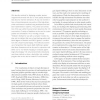Free Online Productivity Tools
i2Speak
i2Symbol
i2OCR
iTex2Img
iWeb2Print
iWeb2Shot
i2Type
iPdf2Split
iPdf2Merge
i2Bopomofo
i2Arabic
i2Style
i2Image
i2PDF
iLatex2Rtf
Sci2ools
PRESENCE
2000
2000
Virtual Environments with Four or More Spatial Dimensions
We describe methods for displaying complex, texturemapped environments with four or more spatial dimensions that allow for real-time interaction. At any one moment in time, a three-dimensional cross section of the high-dimensional environment is rendered using techniques that have been implemented in OpenGL. The position and orientation of the user within the environment determine the 3-D cross section. A variety of interfaces can be used to control position and orientation in 4-D, including a mouse "freelook" interface for use with a computer monitor display, and an interface that uses a head-tracking system with three degrees of freedom and PINCH gloves in combination with a head-mounted display. The methods avoid the use of projections that require depth buffering in greater than three dimensions and can be used in conjunction with either 2-D or 3-D texture mapping. A computer graphic engine that displays 4-D virtual environments interactively uses these methods, as does ...
| Added | 19 Dec 2010 |
| Updated | 19 Dec 2010 |
| Type | Journal |
| Year | 2000 |
| Where | PRESENCE |
| Authors | Michael D'Zmura, Philippe Colantoni, Gregory Seyranian |
Comments (0)

